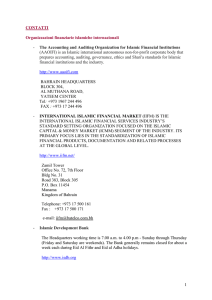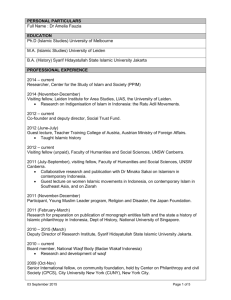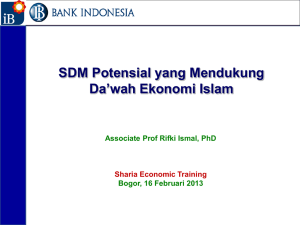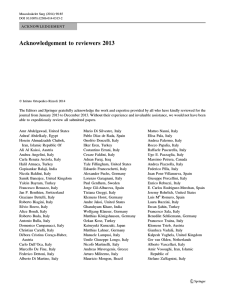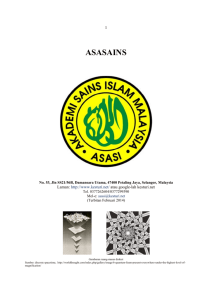I. Reflections - Ekonomi Syariah
advertisement
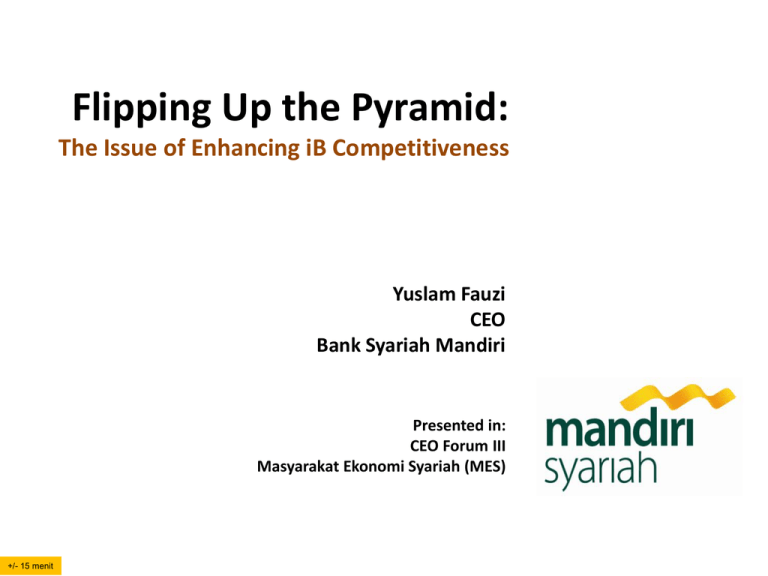
Flipping Up the Pyramid: The Issue of Enhancing iB Competitiveness Yuslam Fauzi CEO Bank Syariah Mandiri Presented in: CEO Forum III Masyarakat Ekonomi Syariah (MES) +/- 15 menit Contents 1 Reflections a. Maqasid al Sharia b. Human Capital Readiness II Characteristics & Prospects of Indonesia a. b. Historical Economic & Business III What Islamic Bank Should Do? IV Expectations 2 I. Reflections a. Maqasid al Sharia Menurut Imam Al-Syatibi: Tujuan syariah adalah terciptanya kesejahteraan manusia Al Muwafaqat Fi Ushul Al-Syariah, 2:8 Firman Allah SWT: “Dialah (Allah) yang telah menciptakan kalian dari Bumi (tanah) dan telah meminta kalian untuk memakmurkannya (Bumi)” Q.S. Hud: 61 3 I. Reflections a. Maqasid al Sharia Contoh dari ayat Quran: “Bukanlah menghadapkan wajahmu ke arah timur dan barat itu suatu kebajikan, akan tetapi sesungguhnya kebajikan itu ialah beriman kepada Allah, hari kemudian, malaikat-malaikat, kitab-kitab, nabi-nabi dan memberikan harta yang dicintainya kepada kerabatnya, anak-anak yatim, orang-orang miskin, musafir (yang memerlukan pertolongan) dan orang-orang yang meminta-minta; dan (memerdekakan) hamba sahaya, mendirikan shalat, dan menunaikan zakat; dan orang-orang yang menepati janjinya apabila ia berjanji, dan orang-orang yang sabar dalam kesempitan, penderitaan dan dalam peperangan. Mereka itulah orang-orang yang benar (imannya); dan mereka itulah orang-orang yang bertakwa. ” (QS. Al-Baqarah [2]: 177.) 4 I. Reflections a. Maqasid al Sharia Al Fajr (15 – 20) Verses Translation Arabic 15 16 17 18 19 20 5 I. Reflections a. Maqasid al Sharia Affluent Poor Middle Class At least, 4 billion people live on less than $2 a day Source: CK Prahalad, 2004. The Fortune at The Bottom of The Pyramid Sharia banks should become the locomotive in flipping up the economic pyramid The flipped economic pyramid once occurred in caliphate of `Umar ibn `Abd al`Aziz, where it was very difficult to find zakat beneficiary (mustahiqq) 6 I. Reflections a. Maqasid al Sharia In BSM 66.4% 63.4% 61.9% 61.5% 56.7% 55.8% 53.6% 46.4% 44.2% 36.7% 43.3% 38.6% 38.1% 33.6% Jun-05 Des-05 Des-06 Korporasi Des-07 Des-08 Des-09 Des-10 UMKM (Non Korporasi) Financing composition changed from corporate majority to non corporate majority 7 I. Reflections a. Maqasid al Sharia Daftar 42 Negara Muslim (Majority) No. Negara % Muslim 1 Afghanistan 99,7 2 Tunisia 99,5 3 Iran (Islamic Republic of) 99,4 4 Azerbaijan 99,2 5 Yemen 99,1 6 Mauritania 99,1 7 Morocco 99,0 8 Iraq 99,0 9 Niger 98,6 10 Somalia 98,5 11 Maldives 98,4 12 Comoros 98,3 13 Jordan 98,2 14 Turkey 98,0 15 Algeria 98,0 16 Occupied Palestinian Territories 98,0 17 Saudi Arabia 97,0 18 Djibouti 96,9 19 Libyan Arab Jamahiriya 96,6 20 Uzbekistan 96,3 21 Pakistan 96,3 No. Negara 22 Senegal 23 Kuwait 24 Gambia 25 Egypt 26 Turkmenistan 27 Mali 28 Syrian Arab Republic 29 Bangladesh 30 Indonesia 31 Oman 32 Kyrgyzstan 33 Guinea 34 Tajikistan 35 Bahrain 36 Albania 37 Qatar 38 United Arab Emirates 39 Sudan 40 Sierra Leone 41 Brunei Darussalam 42 Malaysia % Muslim 96,0 95,0 95,0 94,6 93,1 92,5 92,2 89,6 88,2 87,7 86,3 84,4 84,1 81,2 79,9 77,5 76,2 71,3 71,3 67,2 60,4 8 I. Reflections a. Maqasid al Sharia 1. HDI negara-negara muslim lebih rendah dibanding dengan HDI negaranegara non-muslim. Statistik: Human Development Index (HDI) Negara Muslim Bukan Negara Muslim Rerata HDI 0,578 0,654 Top 30 HDI 0% 100% Top 40 HDI Top 50 HDI 8% 1. United Arab Emirates (rank 32) 2. Brunei Darussalam (rank 37) 3. Qatar (rank 38) 4. Bahrain (rank 39) Penduduk Muslim: +/- 5,2 juta (0,37% dari total muslim dunia) 10% 1. All above + 2. Kuwait (rank 47) Penduduk Muslim: +/- 8 juta orang (0,57% dari total muslim dunia) 92% 90% Bandingkan dengan total muslim di Eropa sebesar +/51,46 juta 9 I. Reflections a. Maqasid al Sharia 2. Education Index negara-negara muslim lebih rendah dibanding dengan Education Index negara-negara non-muslim. Statistik: Education Index (EI) Negara Muslim Bukan Negara Muslim Rerata EI 0,502 0,606 Top 30 EI 0% 100% Top 40 EI 0% 100% Top 50 EI 2% 98% 1. Bahrain (rank 49) Penduduk muslim: • +/- 642 ribu • hanya 0,05% dari total muslim dunia • lebih rendah dari total muslim di Jerman sebesar 4 juta orang Bandingkan dengan total muslim di Eropa sebesar +/51,46 juta 10 I. Reflections a. Maqasid al Sharia 3. Life Expectancy Index negara-negara muslim lebih rendah dibanding dengan Life Expectancy Index negara-negara non-muslim. Statistik: Life Expectancy Index (LEI) Negara Muslim Bukan Negara Muslim Rerata LEI 0,747 0,780 Top 30 LEI 0% 100% Top 40 LEI 2% 1. Kuwait (rank 39) , penduduk 2,8 juta (0,2% total muslim dunia) Top 50 LEI 8% 1. 2. 3. 4. Kuwait + United Arab Emirates (rank 41) Brunei Darussalam (rank 42) Albania (rank 45) Penduduk muslim: • +/- 9,24 juta • hanya 0,65% dari total muslim dunia 98% 92% Bandingkan dengan total muslim di Eropa sebesar +/51,46 juta 11 I. Reflections a. Maqasid al Sharia 4. GNI pc negara-negara muslim lebih rendah dibanding dengan GNI pc negara-negara non-muslim. Statistik: Negara Muslim Bukan Negara Muslim Rerata GNI pc 11.567 13.797 Top 30 GNI pc 8% 92% Top 40 GNI pc 14% 86% 1. 2. 3. 4. 5. 6. 7. Qatar (rank 2) Uni Arab Emirate (rank 4) Kuwait (rank 5) Brunei Darussalam (rank 7) Bahrain (rank 31) Oman (rank 33) Saudi Arabia (rank 36) Penduduk muslim: • +/- 35,5 juta • hanya 32,51% dari total muslim dunia Top 50 GNI pc 8% Bandingkan dengan total muslim di Eropa sebesar +/51,46 juta 92% 12 I. Reflections a. Maqasid al Sharia 5. Top 10 negara muslim adalah natural resource-based economy Top 10 HDI of Muslim Country Natural resource based-economy No. Top 10 HDI in Muslim Country 1 United Arab Emirates 2 Brunei Darussalam 3 Qatar 4 Bahrain 5 Kuwait 6 Libyan Arab Jamahiriya 7 Saudi Arabia 8 Malaysia 9 Albania 10 Azerbaijan HDI % Muslim 0.815 76.2 0.805 67.2 0.803 77.5 0.801 81.2 0.771 95.0 0.755 96.6 0.752 97.0 0.744 60.4 0.719 79.9 0.713 99.2 Top 10 HDI in The World Norway Australia New Zealand United States Ireland Liechtenstein Netherlands Canada Sweden Germany ⃰ KEI* 6.66 N/A 6.15 6.02 6.01 N/A 5.15 6.06 4.04 3.81 1. Knowledge Economic Index (KEI) rendah 2. Rerata KEI sebesar 5,49 Knowledge based-economy Top 10 HDI of the World No. 1 2 3 4 5 6 7 8 9 10 Economic Driver Natural Resource-Based Natural Resource-Based Natural Resource-Based Natural Resource-Based Natural Resource-Based Natural Resource-Based Natural Resource-Based Natural Resource-Based Natural Resource-Based Natural Resource-Based HDI % Muslim 0.938 1.0 0.937 1.7 0.907 0.9 0.902 0.8 0.895 0.5 0.891 4.8 0.890 5.7 0.888 2.0 0.885 2.0 0.885 4.0 Economic Driver Knowledge-Based Knowledge-Based Knowledge-Based Knowledge-Based Knowledge-Based Knowledge-Based Knowledge-Based Knowledge-Based Knowledge-Based Knowledge-Based KEI* 9.27 8.89 8.87 9.08 8.92 N/A 9.32 9.21 9.52 8.87 1. Knowledge Economic Index (KEI) tinggi 2. Rerata KEI sebesar 9,11 The Knowledge Economy Index (KEI) takes into account whether the environment is conducive for knowledge to be used effectively for economic development 13 I. Reflections a. Maqasid al Sharia 6. Indonesian Prosperity HDI Indonesia 2010 Indikator Value Ranking HDI 0,600 108 Life Expectancy Index 0,815 Kontribusi positif terhadap HDI Education Index 0,539 Kontribusi negatif terhadap HDI Income Index 0,491 Keterangan Kontribusi negatif terhadap HDI - Tahun 2009, dari 184 negara, Indonesia menempati peringkat 111 dengan HDI Index: 0,734. - Tahun 2010, dari 192 negara, Indonesia berada pada peringkat ke-108 mengalami peningkatan dibanding tahun 2009. - Faktor utama penyebab rendahnya HDI Indonesia adalah tingkat Income Indeks dan Education Index. 14 I. Reflections b. Human Capital Readiness Islamic Banking Asset (IDR Trillion) Human Resource (Thousand) 1.800* 101* 97.5 83 thousand human resources gap to be solved 18 2020 2010 * Assumption: 1. the ratio of asset per employee increases by 13% per year based on data 2007 to 2010 2. Asset growth 34% p.a. 1. 2. 3. 4. Islamic banking growth must be supported by ...... thousands resources All of them must have hi-competences and unquestionable integrity How can we deal with this challenge? What kind of education we need to deal with? 15 Contents 1 Reflections a. Maqasid al Sharia b. Human Capital Readiness II Characteristics & Prospects of Indonesia a. b. Historical Economic & Business III What Islamic Bank Should Do? IV Expectations 16 II. Characteristics & Prospects of Indonesia a. Historical: Growth Driver to retain Petrodollar & to reach int’l investment Middle East Abundant Petrodollars Europe Malaysia Society–driven iB Indonesia Islamic Banking Governmentdriven iB 1. Different country/nation has different characteristics in developing Islamic banking; 2. There is a need for developing nation-based iB product development. 17 II. Characteristics & Prospects of Indonesia a. Historical: Growth Driving Factor in Middle East Oil prices are rising; Islamic banks are flush with funds and are driving growth on the back of strong recent performances. 1. Propelled by rising oil prices and economic diversification, GCC (Gulf Cooperation Council) countries are growing rapidly. 2. Islamic banks, or banks that offer Islamic banking units, have a market that holds half of the world’s oil reserves and whose citizens have an estimated $1.5 trillion in private wealth, according to the International Monetary Fund. Source: Rajashekara V Maiya, Basudev Banerjee. 2009. Banking on Faith: Islamic Banking in the Middle East. Prespective. Finale Infosys. Islamic banks in Middle East are petrodollar-driven 18 II. Characteristics & Prospects of Indonesia a. Historical: Growth Driving Factor in Europe 1. An added spur is the huge liquidity overhang in the Gulf due to the high petroleum prices for which Shariah compliant investments are the channel of choice. 2. This situation has led to European states promoting their acceptance of Islamic finance. 3. Europe’s acceptance of Islamic finance is a natural follow-through to the emergence of a sizeable Muslim middle and upper classes, but the players are eyeing the overall population as a cycle of financial and credit crises pushes consumers to seek ethical financial services. Source: Islamic Finance News, Vol. 5, Issue 355th, September 2008 www.assaif.org/content/download/1243/8684/version/1/file/IFN+Sept.+08.pdf The main reason behind the development of Islamic bank in Europe is due to the opportunity maximization of huge liquidity of in the Gulf countries. 19 II. Characteristics & Prospects of Indonesia a. Historical: Growth Driving Factor in Malaysia Government of Malaysia has played significant role on boosting Islamic banking industry Source: Jennifer Chang. 2009. Incentives from the Malaysian Government. Islamic Venture Capital & Private Equity Conference 2009. PriceWaterHouseCoopers. Online. www.assaif.org/content/download/3046/18281/file//Incentives%20from%20the%20Malaysian%20Government-Jennifer%20Chang.pdf 20 II. Characteristics & Prospects of Indonesia a. Historical: Growth Driving Factor in Indonesia Two ministers’ Joint decree: - Religious-based school teach general studies - Public school teach religious studies Family of “Santrinic” just have Bachelor Deg 1st Generation Elementary Senior High Sch ICMI (the origin of social Islamization) Islamic Banking Booming Diploma Degree 1949 1955 1961 1965 1970s 1980s 1990s 2000s A dichotomy era of “santrinic” *and “abangan”** Organisational leaders come from santrinic family, a diploma graduate, which has experienced in public school Newly fashionable of “Mosque in office” and veil • • Islamic banking is an accumulated result of those two minister’s joint decree At present, the development of Islamic banking has become the driving force of the development other Islamic finance & economic practices *Santrinic is terminology to describe to those who has more concern on religion **Abangan is a terminology to describe to those who has less concern on religion or syncretism. 21 II. Characteristics & Prospects of Indonesia b. Economic & Business: Population (Middle Class) Recently, Indonesia has about 102 mn middle class Sources: Key Indicator for Asia and Pacific (barrolee.com) 22 II. Characteristics & Prospects of Indonesia b. Economic & Business: Population (Middle Class) 1. 2. 3. Sources: Key Indicator for Asia and Pacific (barrolee.com), BPS, Facebook, media reports, A.T. Kearney analysis Middle-class in Indonesia will be doubled Household consumption as GDP growth driver There is gonna be a big challenge to solve 23 II. Characteristics & Prospects of Indonesia b. Economic & Business: Population (Middle Class) 24 II. Characteristics & Prospects of Indonesia b. Economic & Business: Future Economy Source: IMF, Standard Chartered Research (Desember, 2010) 1. Growing 7% per year, Indonesia shall become the fifth biggest economies in the world by 2030. 2. The Indonesian economy prospect should affect to the Bottom of the Pyramid. For Islamic bank, this requires sophisticated capabilities of Islamic banking in providing products & services. 25 Contents 1 Reflections a. Maqasid al Sharia b. Human Capital Readiness II Characteristics & Prospects of Indonesia a. b. Historical Economic & Business III What Islamic Bank Should Do? IV Expectations 26 III. What Islamic bank should do? ? How to inline the wealth creation & distribution issues in the light of Indonesian economy prospective in the next two decades? What should Islamic bank do next? What business model should Islamic bank pursue? 27 III. What Islamic bank should do? How Islamic banks should take the role? Islamic banks Shari’a mission • Islamic banks should implement its main mission: wealth creation & distribution Affluent Take opportunity optimally • Islamic banks is supposedly able to take optimally these opportunities thru advancing technology, innovating product scheme, and creating new business models, etc. 28 III. What Islamic bank should do? ..Giving fair competitiveness & incentives to both BoP Market and Islamic banks become a strategic enabler for succeeding wealth creation & distribution in Indonesia… Competition Fairness • • • • • Fiskal (?) ATMR (?) Relaksasi regulasi (?) Relaksasi syariah (?) Dst Which one is better & relevant for wealth creation & distribution? Incentives • • • • • Fiskal (?) ATMR (?) Relaksasi regulasi (?) Relaksasi syariah (?) Dst 29 Contents 1 Reflections a. Maqasid al Sharia b. Human Capital Readiness II Characteristics & Prospects of Indonesia a. b. Historical Economic & Business III What Islamic Bank Should Do? IV Expectations 30 IV. Expectations 1. To Regulators & Ulama: Contextualization & Reactualization …The most challenging of Islamic bank on tapping up the BoP Market is more than providing customized, simple, and cheap Products, but on how shari’a compliance deals with flexibility & cost… BoP Market Segment 1 Customised Products 2 Pembiayaan Sektor Pertanian Contraints: No “IDC” syariah Possible solutions: Margin During Construction/Plantation Sharia Compliance Flexibility Simple products 3 Cheap products Context: Pembiayaan Multi Guna Contraints: compliance cost • PMG Konsumer: satu obyek satu akad. Solusi: satu paket satu akad • PMG Konsumer/Mikro: Tawarruq. Possible solutions: Bai’ Al Inah • Pembiayaan Executing: satu akad satu disbursement. Possible solutions: ?? • dsb Operational cost Kontekstualisasi & Reaktualisasi Compliance cost 31 IV. Expectations 2. To the Government: Tax Fairness Instead of Tax Incentives We need Tax (Case of Malaysia) Fairness (a Proposal for Indonesia) Tax Incentives Tax Fairness 1. 2. 3. To create fair competition, Islamic banking must be placed in “the same playing ground” with the conventional one Tax fairness could be considered See one example in the next slide 32 IV. Expectations 2. To the Government: Tax Fairness Income Tax of Depositors Customer’s Question: “Why are we (depositors) charged with the same tax rate while facing higher uncertainty in Islamic Banking?” 33 IV. Expectations 2. To the Government: Tax Fairness Income Tax of Depositors Income Tax For Depositors/ Investors Conventional Commercial Bank Islamic Commercial Bank Investment Bank Both principal and interest are guaranteed Principal is guaranteed but yield is not guaranteed Both principal and interest are not guaranteed Debt Culture (low risk) In Between (moderate risk) Equity Culture (high risk) Interest Profit Sharing Dividend 20% 20% 1. 2. 3. ? 15% Corporate Tax 10% Individual Tax Based on the risk-return principle, is 20% of Income Tax for islamic banking depositors fair? How much is the appropriate percentage of tax for Islamic banking depositors (investment account)? We think it should be lower than 20% 34 IV. Expectations 2. To the Government : Human Capital Quality of the educational system How well does the educational system in your country meet the needs of a competitive economy? [1 = not well at all; 7 = very well] Therefore, to fully utilize the ‘window of opportunity’ in 20202030, Indonesia needs to immediately initiate policies and programs to prepare high quality human capital to meet the rapid changing demand of labor Source: Klaus Schwab. 2010. The Global Competitiveness Report 2010–2011. World Economic Forum. Geneva, Switzerland 2010 Intenational Labor Org. (ILO) - Indonesia Source: ILO Jakarta News Letter. 2008. Indonesia-ILO to Continue Tackling the Worst Forms of Child Labour. http://www.ilo.org/wcmsp5/groups/public/---asia/---robangkok/documents/publication/wcms_101368.pdf . 1. 2. 3. Education in Indonesia has not matched yet with business needs Can our education meet Islamic banking needs? Supposedly, educational institution can play hand in hand with business player, especially Islamic banking players 4. We should consider tax incentives for sharia human capital development 35 IV. Expectations 2. To the Government : Human Capital Islamic Banking Asset (IDR Trillion) Human Resource (Thousand) 1.800* 101* 97.5 83 thousand human resources gap to be solved 18 2020 2010 * Assumption: 1. the ratio of asset per employee increases by 13% per year based on data 2007 to 2010 2. Asset growth 34% p.a. 1. 2. 3. 4. Islamic banking growth must be supported by 83 thousands resources All of them must have hi-competences and unquestionable integrity How can we deal with this challenge? What kind of education we need to deal with? 36 IV. Expectations 2. To the Government : Human Capital Lessons Learnt from Malaysia 1. Tax incentives on training in Islamic Finance 2. Tax exemption for non-resident Islamic finance expert 3. Additional 20% stamp duty exemption on Islamic Financial instruments 4. Tax deduction for promoting MIFC 37 IV. Expectations 2. To the Government : Human Capital Experience Islamic banking practitioners are unsatisfied with unfair decision made by court due to lack of understanding of Islmic economic and finance. Islamic banking had unnecesary lost Government should take a role to equip adequate training for judges who are involved in dispute in sharia economic & finance 38 Finish 39
